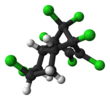Chlordane
[4] Chlordane was banned 10 years earlier for food crops like corn and citrus, and on lawns and domestic gardens.
[5] Like other chlorinated cyclodiene insecticides, chlordane is classified as an organic pollutant hazardous for human health.
Technical chlordane development was by chance at Velsicol Chemical Corporation by Julius Hyman in 1948, during a search for possible uses of a by-product of synthetic rubber manufacturing.
[8][9] Chlordane appears as a white or off-white crystals when synthesized, but it was more commonly sold in various formulations as oil solutions, emulsions, sprays, dusts, and powders.
Because of concern for harm to human health and to the environment, the United States Environmental Protection Agency (EPA) banned all uses of chlordane in 1983, except termite control in wooden structures (e.g. houses).
[11] In the years 1948–1988 chlordane was a common pesticide for corn and citrus crops, as well as a method of home termite control.
[13] Chlordane is excreted slowly through feces, urine elimination, and through breast milk in nursing mothers.
[15] Being hydrophobic, chlordane adheres to soil particles and enters groundwater only slowly, owing to its low solubility (0.009 ppm).
[26] The non-cancer health effects of chlordane compounds, which include diabetes, insulin resistance, migraines, respiratory infections, immune-system activation, anxiety, depression, blurry vision, confusion, intractable seizures as well as permanent neurological damage,[27] probably affects more people than cancer.
Trans-nonachlor and oxychlordane in serum of mothers during gestation has been linked with behaviors associated with autism in offspring at age 4–5.
[28] The Agency for Toxic Substances and Disease Registry (ATSDR) has defined a concentration of chlordane compounds of 20 ng/m3 as the Minimal Risk Level (MRLs).





